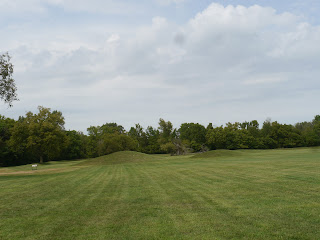There was our first problem. There are so many mounds, and they are not that close to each other, that much time is spent figuring out which mound. There the National Park Service ones in Hopewell, or the large cone-shaped one in Miamisburg, or Serpent Mound in Peebles (an internationally known National Historic Landmark), or Story Mound in Chillicothe. Now I have the official Passport to Your Ohio History book, so maybe we can use this to check off historic sites?
 We went with the Hopewell Mound (I think you already figured that out by the title of this post).
We went with the Hopewell Mound (I think you already figured that out by the title of this post). There are actually a few mounds in the area we could have visited on the same trip, but between the late start and the plans to go to a concert that night, we ran out of time.
 The loop around the Hopewell Mound is about a mile. We walked half-way on the outer loop, before cutting into the center and walking around the inner part, careful to not walk on the mounds themselves.
The loop around the Hopewell Mound is about a mile. We walked half-way on the outer loop, before cutting into the center and walking around the inner part, careful to not walk on the mounds themselves. | ||||||||
| Pole posts left to indicate where the ceremonial hut was built. |
The Hopewell Mounds was about 130 acres, and had a earthen wall that was about two miles long.
Two thousand years ago. That would be when Jesus and Julius Caesar lived. Sometimes it helps to put life in a greater context.
 The Native Americans hauled the materials needed for these mounds -- dirt, clay, sand, copper, etc. -- over many miles without modern equipment. While many Mounds were used for a couple of hundred years, there is evidence this one was used for at least 400 years. Archaeologists have been studying since 1820 -- two hundred years -- when the field of archaeology was new.
The Native Americans hauled the materials needed for these mounds -- dirt, clay, sand, copper, etc. -- over many miles without modern equipment. While many Mounds were used for a couple of hundred years, there is evidence this one was used for at least 400 years. Archaeologists have been studying since 1820 -- two hundred years -- when the field of archaeology was new.We chose this Mound over the others because it is a National Park Service Mound, and because it has a Visitor's Center with a movie (which sadly I slept through) and a small museum with reproductions of what was found. Seems I have to travel to England in order to see the originals. They were sold in the 19th century to help fund the expedition. Archaeology has come a long way. This summer we were told our finds had to stay in stay in Israel where they will be studied.
Over the years the Mounds were flattened by farmers plowing the fields. During World War I this site was used to house soldiers training to become soldiers. A lot can change in 2,000 years, especially in a country as young as ours.
After I came home I was talking to Debbi about these. She has seen others along the Mississippi River. They still look like piles of grass to me.
No comments:
Post a Comment